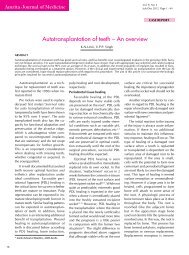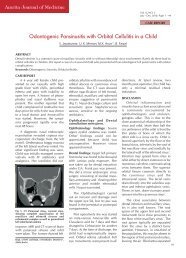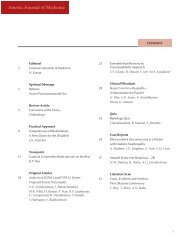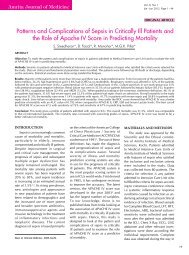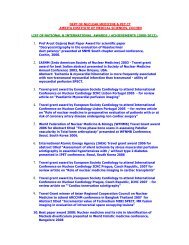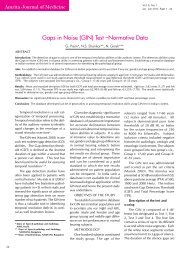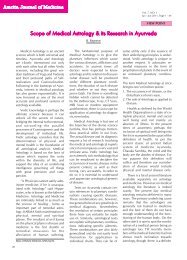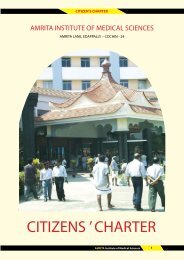Journal of Medicine Vol 2 - Amrita Institute of Medical Sciences and ...
Journal of Medicine Vol 2 - Amrita Institute of Medical Sciences and ...
Journal of Medicine Vol 2 - Amrita Institute of Medical Sciences and ...
You also want an ePaper? Increase the reach of your titles
YUMPU automatically turns print PDFs into web optimized ePapers that Google loves.
<strong>Amrita</strong> <strong>Journal</strong> <strong>of</strong> <strong>Medicine</strong><br />
Hypercoagulable States<br />
thrombin enzymatic active site. The rate <strong>of</strong> thrombin inhibition<br />
by Antithrombin III is increased markedly by<br />
glycosaminoglycans (e.g. heparin).<br />
Familial reductions in plasma Antithrombin III, Protein<br />
C, or Protein S activity due to either reduced plasma<br />
protein levels (i.e. altered protein expression), or normal<br />
levels <strong>of</strong> a dysfunctional protein (i.e. altered protein structure),<br />
are strongly associated with deep vein thrombosis<br />
<strong>and</strong> pulmonary embolism (venous thromboembolism),<br />
<strong>and</strong> validate the important role <strong>of</strong> these proteins in the<br />
natural anticoagulant system.<br />
Our underst<strong>and</strong>ing <strong>of</strong> these mechanisms continues to<br />
evolve as new genetic abnormalities are defined <strong>and</strong> new<br />
anticoagulant pathways are discovered.<br />
ANTITHROMBIN, PROTEIN C, AND<br />
PROTEIN S<br />
Deficiencies <strong>of</strong> Antithrombin, Protein C, <strong>and</strong> Protein<br />
S are inherited in an autosomal dominant pattern. All<br />
three generally present with a first episode <strong>of</strong> thrombosis<br />
between the ages <strong>of</strong> 10 <strong>and</strong> 50 years.<br />
Adults with heterozygous Protein C or Protein S deficiency<br />
may experience skin necrosis shortly after starting<br />
warfarin therapy without concomitant heparin therapy.<br />
Both Protein C <strong>and</strong> Protein S are vitamin K-dependent<br />
c<strong>of</strong>actors whose levels may drop precipitously after initiation<br />
<strong>of</strong> warfarin, leading to transient hypercoagulation.<br />
Several acquired conditions, including liver disease <strong>and</strong><br />
disseminated intravascular coagulation, can lead to decreased<br />
activity <strong>of</strong> Protein C <strong>and</strong> Protein S. A decreased<br />
Protein S level has also been specifically noted to occur<br />
with pregnancy, oral contraceptive use, <strong>and</strong> the nephrotic<br />
syndrome.<br />
Acquired Antithrombin deficiency is seen with liver<br />
disease, oral contraceptive use, the nephrotic syndrome,<br />
pregnancy, <strong>and</strong> disseminated intravascular coagulation.<br />
FACTOR V LEIDEN<br />
APC resistance is most commonly due to a point<br />
mutation in the gene encoding factor V. Factor V Leiden<br />
is the single most common inherited thrombophilic defect.<br />
Heterozygosity for factor V Leiden mutation imparts<br />
a sevenfold increased lifetime risk <strong>of</strong> venous thromboembolism,<br />
whereas homozygous expression confers an<br />
80-fold increased risk.<br />
Although Antithrombin, Protein S, <strong>and</strong> Protein C deficiencies<br />
usually present with thrombosis relatively early<br />
in life, the risk <strong>of</strong> thrombosis due to factor V Leiden increases<br />
with age. Coinheritance <strong>of</strong> other thrombophilic<br />
mutations, such as Protein C deficiency, Prothrombin<br />
20210, or Hyperhomocystinemia, further increases thrombotic<br />
risk.<br />
PROTHROMBIN 20210<br />
Prothrombin 20210 is an autosomal dominant inherited<br />
defect. Prothrombin 20210 confers a weaker<br />
thrombotic risk (about threefold) than factor V Leiden 1,2 .<br />
Coinheritance <strong>of</strong> both Factor V Leiden <strong>and</strong> Prothrombin<br />
20210 compounds the risk <strong>of</strong> venous thromboembolism,<br />
pregnancy-associated venous thromboembolism, <strong>and</strong> recurrent<br />
venous thromboembolism.<br />
Table 2: Unusual Venous Thrombotic Presentations <strong>of</strong> Certain Hypercoagulable States<br />
VTE Presentation<br />
Cerebral vein thrombosis<br />
Cerebral vein thrombosis in women using oral contraceptive<br />
pills<br />
Inferior vena cava, renal vein, mesenteric vein, portal <strong>and</strong><br />
hepatic vein thrombosis<br />
Migratory superficial thrombophlebitis (Trousseau’s syndrome)<br />
Recurrent superficial thrombophlebitis<br />
Warfarin skin necrosis<br />
Neonatal purpura fulminans<br />
Unexplained fetal loss (three or more first-trimester<br />
miscarriages or one second- or third-trimester unexplained<br />
death <strong>of</strong> a morphologically normal fetus)<br />
Hypercoagulable Condition<br />
Prothrombin G20210A, Antiphospholipid antibodies,<br />
Antithrombin deficiency, Essential Thrombocythemia,<br />
Paroxysmal Nocturnal Hemoglobinuria<br />
Prothrombin G20210A<br />
Antiphospholipid antibodies, Cancer, Antithrombin deficiency,<br />
Myeloproliferative syndromes, Paroxysmal<br />
Nocturnal Hemoglobinuria<br />
Cancer (particularly adenocarcinoma <strong>of</strong> the gastrointestinal<br />
tract)<br />
Factor V Leiden, Polycythemia Vera, Deficiencies <strong>of</strong> natural<br />
anticoagulants<br />
Protein C <strong>and</strong> Protein S deficiencies<br />
Homozygous Protein C <strong>and</strong> Protein S deficiencies<br />
Antiphospholipid antibodies<br />
14



